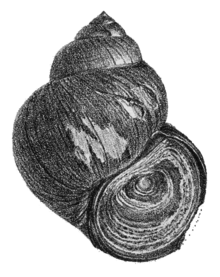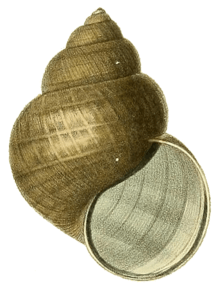Cipangopaludina cathayensis
| Cipangopaludina cathayensis | |
|---|---|
 | |
| Shell and operculum from type description. | |
| Scientific classification | |
| Kingdom: | Animalia |
| Phylum: | Mollusca |
| Class: | Gastropoda |
| (unranked): | clade Caenogastropoda informal group Architaenioglossa |
| Superfamily: | Viviparoidea |
| Family: | Viviparidae |
| Subfamily: | Bellamyinae |
| Genus: | Cipangopaludina |
| Species: | C. cathayensis |
| Binomial name | |
| Cipangopaludina cathayensis (Heude, 1890)[2] | |
| Synonyms | |
|
Paludina catayensis Heude, 1890 (orthographic error) | |
Cipangopaludina cathayensis is a species of large, freshwater snail with an operculum and a gill, an aquatic gastropod mollusk in the family Viviparidae, the river snails.
Taxonomy
This species was described under the name Paludina catayensis by French Jesuit Pierre Marie Heude in 1890.[2] Later reviewers treated the specific name catayensis as an orthographic error and changed the specific name to cathayensis.[3] There is high intraspecific variation of shells within the genus Cipangopaludina,[3] so Wilhelm Kobelt (1909)[4] considered this taxon as a subspecies of Vivipara chinensis. Later authors Yen (1943), Liu (1991) and Lu et al (2014)[3] considered this taxon as a separate species.
Distribution
The species has a wide distribution throughout central and southeastern China, occurring in East China (provinces Shandong, Anhui, Jiangsu, Zhejiang, Jiangxi), Northeast China (Jilin), North China (Shanxi, Hebei) and Central China (Henan, Hubei, Hunan).[1]
Description
The width of the shell is 24.3–50.5 mm.[3] The height of the shell is 27.7–58.5 mm.[3] The shell has from five to six whorls.[3] The apex is pointed.[3]
 Drawing of an apertural view. |
 Drawing of an abapertural view. |
C. cathayensis has gills and an operculum. The kidney is triple-shaped.[3] The diploid chromosome number of C. cathayensis is 2n=18.[5] The complete mitochondrial genome of Cipangopaludina cathayensis is known since 2014.[6] Its length is 17,157 bp.[6]
Ecology
It inhabits lakes, reservoirs and ponds, as well as grassy paddies, where it clings to aquatic plants.[1]
Each gravid female carries more than 60 embryos inside her.[3] The shell of embryo has three whorls.[3]
The pollutant removal in constructed wetlands with these snails was better, that in constructed wetland without them.[7]
Human use
| Nutritional value per 100 g (3.5 oz) | |
|---|---|
|
3.83 g[8] | |
| Threonine | 2.952 g[8] |
| Isoleucine | 2.026 g |
| Leucine | 5.198 g |
| Lysine | 3.700 g |
| Methionine | 1.145 g |
| Cystine | 1.233 g |
| Phenylalanine | 1.894 g |
| Tyrosine | 2.731 g |
| Valine | 1.894 g |
| Arginine | 4.537 g |
| Histidine | 1.057 g |
| Alanine | 3.524 g |
| Aspartic acid | 6.211 g |
| Glutamic acid | 9.868 g |
| Glycine | 3.340 g |
| Proline | 1.850 g |
| Serine | 2.996 g |
| Other constituents | |
| Water | 77.30 g[8] |
| Crude fat | 0.60 g[8] |
| Crude protein | 13.72 g[8] |
| Crude ash | 4.55 g[8] |
| |
| Percentages are roughly approximated using US recommendations for adults. | |
It is used as human food and in the preparation of medicines, and as feed for fish, poultry and livestock.[1] It is also used as a fertilizer.[1]
References
- 1 2 3 4 5 Köhler F., Do V. & Richter K. (2012). "Cipangopaludina cathayensis". The IUCN Red List of Threatened Species 2012: e.T166255A1123680. Downloaded on 12 February 2016.
- 1 2 (French) Heude P. M. (1890). 4: 125[sic]-188, plates 33–43. page 174, plate 39, figure 10. In: (French) Heude P. M. (1882–1890). "Notes sur les Mollusques terrestres de la vallée du Fleuve Bleu". Mémoires concernant l'histoire naturelle de l'empire chinois par des pères de la Compagnie de Jésus, Mision Catholique, Chang-Hai.
- 1 2 3 4 5 6 7 8 9 10 Lu H.-F., Du L.-N., Li Z.-Q., Chen X.-Y. & Yang J.-X. (2014). "Morphological analysis of the Chinese Cipangopaludina species (Gastropoda; Caenogastropoda; Viviparidae). Zoological Research 35(6): 510–527. doi:10.13918/j.issn.2095-8137.2014.6.510.
- ↑ (German) Kobelt W. (1909). "Die Gattung Paludina Lam. (Vivipara Montfort): Neue Folge. In: Abbildungen Nach de Natur mit Beschreibungen". Systematisches Conchylien–Cabinet von Martini und Chemnitz 1(21a): 97-380, plates 15–77, pages 112–113, plate 18, figure 5-6.
- ↑ Zhou D., Zhou M. & Wu Z. (1988). "The karyotype of five species of freshwater snails of the family Viviparidae". Acta Zoologica Sinica 34: 364–370. abstract.
- 1 2 Yang H., Zhang J. E., Luo H., Luo M., Guo J., Deng Z. & Zhao B. (2014). "The complete mitochondrial genome of the mudsnail Cipangopaludina cathayensis (Gastropoda: Viviparidae)". Mitochondrial DNA: The Journal of DNA Mapping, Sequencing, and Analysis : 1–3. doi:10.3109/19401736.2014.971274.
- ↑ Li P., Zhang J., Xie H., Hu Z., He H. & Wang W. (2015). "Effects of Misgurnus anguillicaudatus and Cipangopaludina cathayensis on Pollutant Removal and Microbial Community in Constructed Wetlands". Water 7(5): 2422–2434. doi:10.3390/w7052422.
- 1 2 3 4 5 6 (Chinese) Hanfeng Z. & Jiale L. (2012). 浙江地区 3 种淡水经济贝类的营养成分分析与评价 "Analysis and Evaluation on Nutritional Components of Three Freshwater Mussels from Zhejiang Province". Chinese Agricultural Science Bulletin 28(2): 78–82. abstract.
Further reading
- Gao M. X. & Yao X. D. (2005). "Research on Taurine Extraction in River-Snail". Journal of Jianghan Petroleum Institute (Social Science Edition) 8: 27. abstract.
- Lei Y. L., Yin W. Z., Zhang Y., Dong W. W. & Tang Z. Y. (2012). "Effect of Cadmium and Mercury on Catalase Activity of the Mudsnail (Cipangopaludina cathayensis)". Journal of Neijiang Normal University 4: 10. abstract.
- Li X. Y., Li Y., Zhou S. Q. & Yan B. L. (2010). "Analysis and evaluation of nutritional composition in two freshwater fingersnails". Food Science 31: 276–279. abstract.
- (Chinese) Shen J., Zhao Y., Li S. & Zhu G. (2013). 三种常用农药对环棱螺, 圆田螺和河蚬的急性毒性研究. "Acute toxicity of three common pesticides to Bellamya quadrata, Cipangopaludina cathayensis and Corbicula fluminea". Chinese Journal of Pesticide Science 15(5): 559–566. doi:10.3969/j.issn.1008-7303.2013.05.13. abstract.
External links
| Wikimedia Commons has media related to Cipangopaludina cathayensis. |
